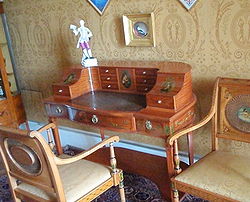For some odd reason I’ve always wanted a roll top desk. Even today it sits quite high on my list of wants. There is a charm and elegance about them that is unmistakable. I write a lot, the old fashioned way with actual paper and pen. The roll top desk is the perfect writing station for somebody that like to daydream about simpler times.
Going back to those days we can see the roots of the roll top. Emerging from 3 styles of desk, the roll top desk took the best of these and evolved its own legendary style.
 The Carleton House desk was one of the precursors to the roll top desk. The Carlton is a fine writing desk credited to a Hepplewhite design. It sports a U shaped group of drawers where papers and writing intruments can be stored. Unlike the roll top it typically has no pigeon holes. Another feature is the slanted drwaers at both ends of the desk a foreshadowing of the sliding cover of the roll-top. This table was said to have been built for the Prince of Walesin the 18th century and as we can see by the image the roots of the typical roll top desk are evident.
The Carleton House desk was one of the precursors to the roll top desk. The Carlton is a fine writing desk credited to a Hepplewhite design. It sports a U shaped group of drawers where papers and writing intruments can be stored. Unlike the roll top it typically has no pigeon holes. Another feature is the slanted drwaers at both ends of the desk a foreshadowing of the sliding cover of the roll-top. This table was said to have been built for the Prince of Walesin the 18th century and as we can see by the image the roots of the typical roll top desk are evident.
Another progenetor of the roll top desk is the Tambour desk. The tambour actually refers to the sliding slats found on both types of desk. The main difference being that the tambour has slats that roll from side to side. The Tambour desk typically has drawers below the writing surface with shorter legs. The writing surface also folds in so that when not is ude the desk occupies much less space. Inside the sliding doors is where we can see the similarities with the roll top. Like the roll top, the tambour has a mix of pigeon holes and small drawers, though there are fewer and the details tend to be less intricate. You aren’t likely to see any hidden spaces inside a Tambour.
Finally the cylinder desk. The cylinder most resembles the roll top desk; it is easy to see how it evolved from this. The cylinder desk has many of the same feautures, a nice set of pigeon holes and drawers (though again, not likely to find any hidden spaces) and a stable writing surface. The cylinder gets its name from the cylinder that comes down to close up and secure the writing area. Like the roll top desk the writing surface does not require you to store your papers before closing the lid. The big difference being that the top is a solid piece of wood and not a ‘tambour’.
The roll top desk itself began to make an appearance in the early nineteenth century in the northen United States. It is basically a desk of drawers with short legs upon which sits a writing area topped off with a series of cubby holes, small drawers and perhaps a secret stash or two. It is essentially a writing desk with spaces designed to hold your mail, notes and writing instruments. For me there is nothing quite like it. Sitting at a beautiful roll top desk brings you back to a simpler time. I can’t think of anyone that actually sits at a desk and writes with pen and paper anymore. Well, I still do and I love it. Hopefully I’ll by a nice solid oak roll top in the near future.
Finishing a Roll Top Desk
